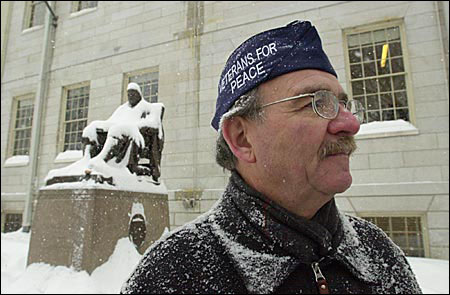Weekly walk for peace undeterred by snow

Snowflakes dusting the shoulders of his overcoat and filling the brim of his brown Homburg, Peter J. Gomes, the Plummer Professor of Christian Morals and Pusey Minister in the Memorial Church, joined the small group that had gathered in front of the John Harvard statue last Wednesday (Jan. 26).The handful of students, University employees, and community members had assembled to participate in the Harvard-Cambridge Walk for Peace, which has taken place every Wednesday at noon for the past eight months. Featured speakers have included Noam Chomsky, Howard Zinn, and James Carroll. Clearly, Gomes had drawn the short straw in terms of weather, but it was not about to stop him from adding his voice to this distinguished chorus.”I’m not the cleverest analyst of American foreign policy, but I knew early on that this war was a bad idea,” Gomes said. “We may not know what to do, but we know that what we’ve done is not right. And the only way it can be addressed is when ordinary people like us stand up and say enough is enough. Individual conscience is the first step in appealing to the national conscience.”The organizer of the weekly walk for peace is Steven Bloomfield, associate director of the Weatherhead Center for International Affairs. Bloomfield said that shortly after the stories of prisoner abuse at Abu Ghraib came out, he became convinced that there ought to be some sort of forum at Harvard to allow people to bear witness against the war in Iraq. Bloomfield shared his concerns with friends, and out of those meetings the weekly march resulted.The usual format is for the guest speaker to deliver a short address or for one of the participants to read a poem or essay. In September, local singer-songwriter Catie Curtis played the guitar and sang. Afterward, the group marches silently through the campus, led by a rainbow peace flag. Individual members carry placards with the names of those who have lost their lives in the fighting.”I felt that opposition to the war should be dignified and thoughtful, and that it should invite discussion,” said Bloomfield.




